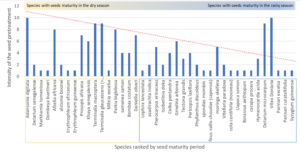Preliminary results of our scientific experiment (see publication of 15 August 2022)
Organising the harvest of forest seeds requires knowledge of the fruiting periods of each species. We recommend establishing a harvesting schedule according to the model in the table below, which is the result of our field surveys, combined with online resources [1]. The ideal harvest periods are shown in green (orange: possible start and end of harvest). They correspond to the ecosystem and climatic conditions in the Linko sub-prefecture. This overview of maturity periods allowed us to form three groups of species, to increase harvesting efficiency.


To optimise the germination rate with the method of direct seeding of seedballs, we then analysed four characteristics of our 40 species: seed dormancy and dormancy-breaking pre-treatments [2], seed propagation mode, seed weight and desiccation tolerance.


As dormancy can have an impact on the germination rate, we identified the type of dormancy [3] of each species according to the scientific literature [4]. Then, to determine the type of pre-treatment to be administered to each species to lift the dormancy, we consulted the practical recommendations of the Centre National de Semences Forestières de Ouagadougou, which is an authority on the topic in West Africa. One may note the little congruence between the scientific source and the experience of practitioners.
In the graph below, which represents the 40 species sorted by seed maturity period and the level of pre-treatment intensity recommended by practitioners, it can be seen (red dotted line) that species maturing in the dry season (November-April, on the left of the graph) need pre-treatment to lift their dormancy more often than those maturing before the rains arrive. The 17 dry season species have a pre-treatment intensity of 4.8, while the 23 wet season species have an intensity of 2.9. This seems logical since dry season germination would result in a high mortality rate for the seeds of these early species, which is why they more frequently have dormancy mechanisms.


In our experiment, we applied the required pre-treatments to test groups 1 and 3 to measure the impact of dormancy and of its lifting on germination rates. Our hypothesis was that coating could inhibit dormancy breakage (for physically dormant species) or delay it (for physiologically dormant species).
The seed propagation mode, in the table below, confirms our observation that species adopt different reproductive strategies, depending on whether they mature in the dry season or in the rainy season: in the group of 17 dry season species 7 species are anemochorous and 6 species are zoochorous, while the proportion of zoochorous is significantly higher among species that mature in the wet season:
| Anemochorous | Zoochorous | Barochorous | Autochorous | |
| Maturity in dry season | 41% | 35% | 18% | 6% |
| Maturity in the rainy season | 22% | 61% | 9% | 8% |
It seems that dry season species rely more on natural elements (wind, gravity) for their dissemination. By contrast, rainy season species tend to use animals, perhaps because the latter, protected by the vegetation cover of the wet season, travel greater distances at this time of year. This zoochorous propagation of half of the 40 species selected by arboRise could, in the long term, naturally strengthen arboRise’s reforestation action (especially as the arboRise project aims, in the long term, to establish a forest corridor favouring the movement of fauna between the Haut-Niger national park in Guinea and the Comoé national park in Côte d’Ivoire).
The number of seeds per kilo, and therefore the average weight per seed, is not surprising: seeds spread by wind (anemochores) and self-propelled by explosion (autochores) are the lightest, whereas seeds spread by fauna (zoochores) or gravity (barochores) are the heaviest on average:
| Anemochorous | Zoochorous | Barochorous | Autochorous | |
| Number of seeds by kilo | 7600 | 2470 [5] | 3410 | 10833 |
| Average weight of one seed | 0,13 gr | 0,40 gr | 0,29 gr | 0,09 gr |
The weight per seed also matters in terms of the process of making seedballs, since heavy seeds are easier to handle.
More fundamentally, these observations raise several subsidiary questions:
- Which types of seeds are most suitable for direct sowing? It could be hypothesised (2) that anemochorous, barochorous and autochorous species, which are naturally propagated by wind, gravity or explosion, are better suited to the semi-direct, than zoochorous species which sometimes require passage through the intestinal transit of the animal carrying them.
- Which type of seed benefits most from being coated in clay and charcoal pellets? Here we can hypothesise (3) that coating is detrimental to physically dormant zoochorous species, which are intended to be swallowed and excreted, whereas other species are most often consumed and would benefit more from the protection of a pellet.
Our publication of 30 October will answer these questions and present all the final results of the experiment !
[1] https://www.prota4u.org/database/ ; https://worldagroforestry.org/ ; https://tropical.theferns.info/
[2] According to the guidelines of the Centre National de Semences Forestières in Ouagadougou
[3] Legend : ND = non dormant ; PD = physiological dormancy ; MPD = morphological dormancy ; PY = physical dormancy
[4] Baskin C., Baskin J: Seeds – Ecology, Biogeography, and, Evolution of Dormancy and Germination 2nd Edition, Academic Press, 2014.
[5] 2470 seeds on average, if we exclude two exceptions: Milicia excelsea (475’000 seeds per kilo) and Ficus vallis-choudae (100’000 seeds per kilo)

